The Wrangler 4xe was Jeep’s first plug-in hybrid. Released back in 2021, it’s been a solid seller for the brand, but it hasn’t been without its issues. The 4xe has been recalled no fewer than 14 times over its five-year life, according to the National Highway Traffic Safety Administration (NHTSA).
A few of these recalls, like the malfunctioning side marker lights recall from 2022 or the non-functional reverse lights and camera from 2023, are more inconvenient than serious. But most are pretty serious, with some posing a stall or fire risk.
If I were a 4xe owner, I’d be pretty angry about having to take my Jeep into the dealer 14 times for recalls over five years. It seems some owners are taking the constant recalls in stride, though, because they’re making entire sets of merit badges for their SUVs to show off the recalls they’ve completed.
Wow, Is It That Bad?
If you’ve spent any time in the Subaru community, you’ll know the company does this thing where you can order “Badges of Ownership,” little badges with symbols of stuff you like doing with your Subaru, like camping, off-roading, or driving with your pet. They’ll even ship them to you free of charge, whether you bought your car new or used (all you need is a VIN).

This is sort of like that, but for Wrangler 4xe owners. Loot Designs, a company that makes all sorts of custom badges for Jeeps, has an entire section dedicated specifically to recalls of the 4xe, each with the manufacturer’s recall number and a little graphic representing the reason for the recall.

There are 10 different designs to choose from, meaning not every recall is covered. But all of the big ones are present and accounted for. There are badges for recalls B9A, 95B, and 68C, which are all recalls for the high voltage battery that could fail and cause a fire (the most recent of which was issued earlier this month). For the first two, the badges show a battery with flames on either side. The third one is a bit more tame, with a battery and a flammable symbol paired together.
There’s also Y46, which corresponds to a recall involving faulty seals for 4xe charging cables. That one shows a little charging symbol with bolts of lightning coming from the charging insert. My personal favorite has to be the badge for recall campaign Y94, which discovered that certain first-year 4xes simply stopped displaying their odometers in their digital gauge clusters. This badge shows a four-digit odometer with a bunch of question marks, which is pretty hilarious.
Posted by Chris Hall on Wednesday, November 19, 2025
The main difference between these badges and the Subaru Badges of Ownership is that these aren’t free. Loot Designs wants $20 per badge, or $17 per badge if you buy two or more. A small price to pay to let the car behind know you’ve done your due diligence with required repairs.
Owners Seem To Like The Idea, At Least According to Facebook
The whole reason I found out about these badges is thanks to a post by a user who goes by Ken Powers in the Jeep 4xe Enthusiasts Facebook Group. Powers designed a “badge of honor” of his own for the latest fire warning recall, complete with raised lettering. If you have a 3D printer, you can download and print the design right now.
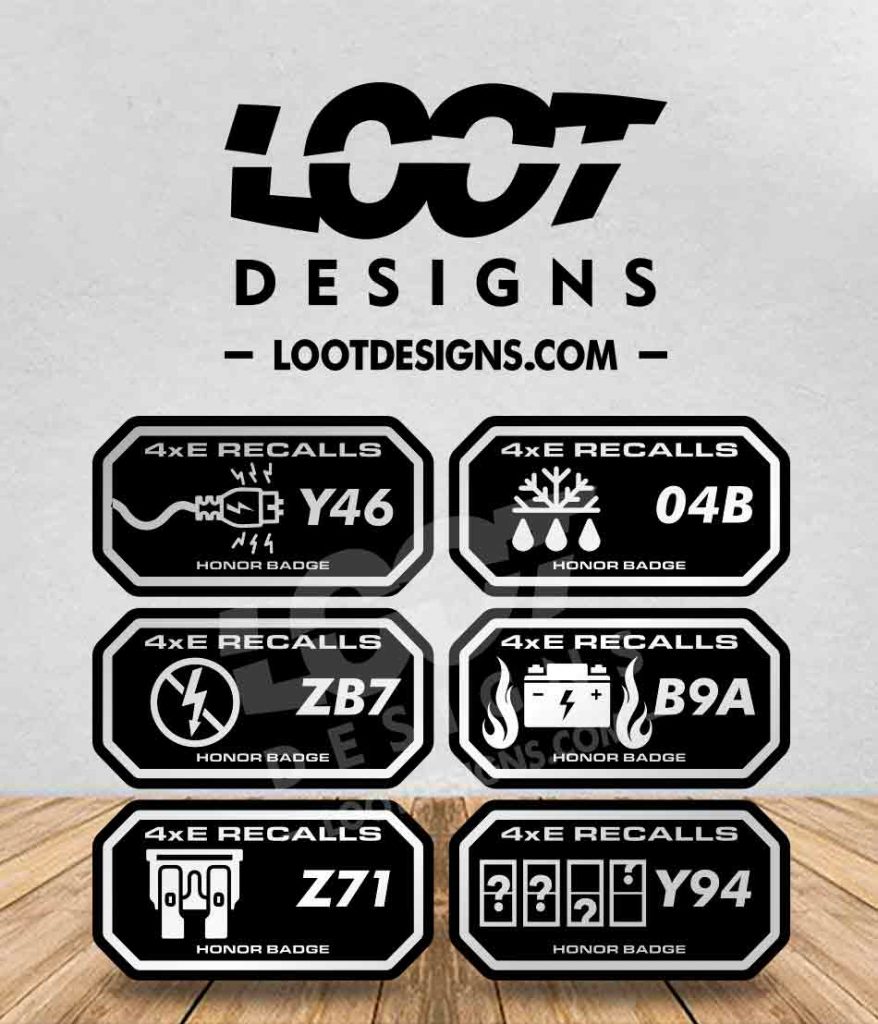
I expected most of the comments to be unsupportive of Powers’ idea, as it highlights flaws in the 4xe’s design. But everyone in the comment section—most of whom are likely other 4xe owners—seemed to love it. “God, what a great idea,” said one commenter. “I will absolutely buy one if you get this to finished product,” said another.
I guess 4xe owners have a pretty good sense of humor. If you managed to hold onto your car even after all these recalls, you must.
Top graphic images: Loot Designs; Jeep
The post This Jeep Is Getting Recalled So Much That Owners Are Making Recall Merit Badges appeared first on The Autopian.
Zork, the classic text-based adventure game of incalculable influence, has been made available under the MIT License, along with the sequels Zork II and Zork III.
The move to take these Zork games open source comes as the result of the shared work of the Xbox and Activision teams along with Microsoft’s Open Source Programs Office (OSPO). Parent company Microsoft owns the intellectual property for the franchise.
Only the code itself has been made open source. Ancillary items like commercial packaging and marketing assets and materials remain proprietary, as do related trademarks and brands.
“Rather than creating new repositories, we’re contributing directly to history. In collaboration with Jason Scott, the well-known digital archivist of Internet Archive fame, we have officially submitted upstream pull requests to the historical source repositories of Zork I, Zork II, and Zork III. Those pull requests add a clear MIT LICENSE and formally document the open-source grant,” says the announcement co-written by Stacy Hafner (director of the OSPO at Microsoft) and Scott Hanselman (VP of Developer Community at the company).
Microsoft gained control of the Zork IP when it acquired Activision in 2022; Activision had come to own it when it acquired original publisher Infocom in the late ’80s. There was an attempt to sell Zork publishing rights directly to Microsoft even earlier in the ’80s, as founder Bill Gates was a big Zork fan, but it fell through, so it’s funny that it still ended up in the same place eventually.
To be clear, this is not the first time the original Zork source code has been available to the general public. The aforementioned Jason Scott uploaded it to GitHub in 2019, but the license situation was unresolved, and Activision or Microsoft could have issued a takedown request had they wished to.
Now that’s obviously not at risk of happening anymore.
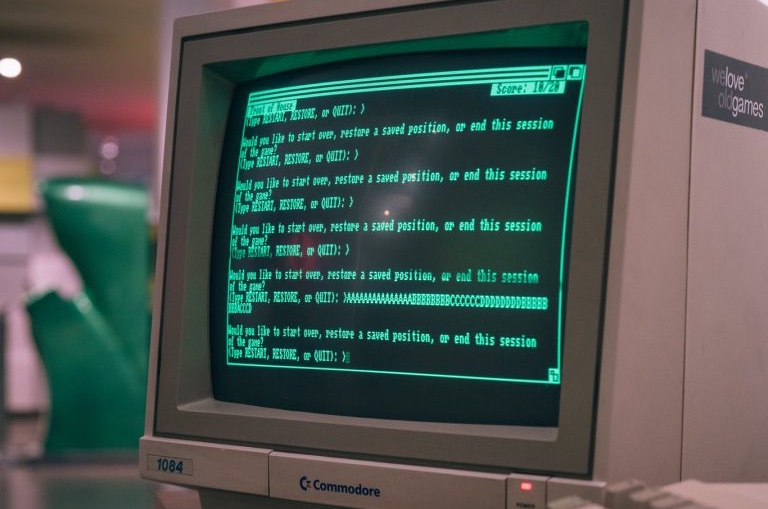
Ah, the EV1. General Motors’ electric moonshot of the late 1990s has become a legend, solidifying itself as the first modern EV for the masses, despite just a handful being leased to owners—several of whom were celebrities—before they were taken back by the company and mostly crushed.
The EV1’s tale is a fascinating one, with tons of data out there about how the car came to be, and all of the interesting ways engineers made it happen. I highly recommend reading David Tracy’s write-up on the EV1 factory service manuals he picked up last year, or our exclusive story on how there was nearly an EV1 convertible.
With just 137 horsepower from a single electric motor, 26 lead-acid batteries, and around 90 miles of range, the EV1 wasn’t exactly mind-blowing by modern EV standards. But it was vastly ahead of its time. This was a viable battery-powered car that hit the market over 10 years before the Tesla Roadster, after all. GM was way ahead of the game and in a position to set itself up for success in the decades to come.
Of course, everyone knows what happened next. Low demand and high costs forced GM to cancel the EV1 program, despite owners voicing their praise for the car. GM collected every example and crushed them, aside from around 40 cars, which were donated to museums and universities. It would be another decade until GM introduced another electric car to the market, the Spark EV, in 2013.
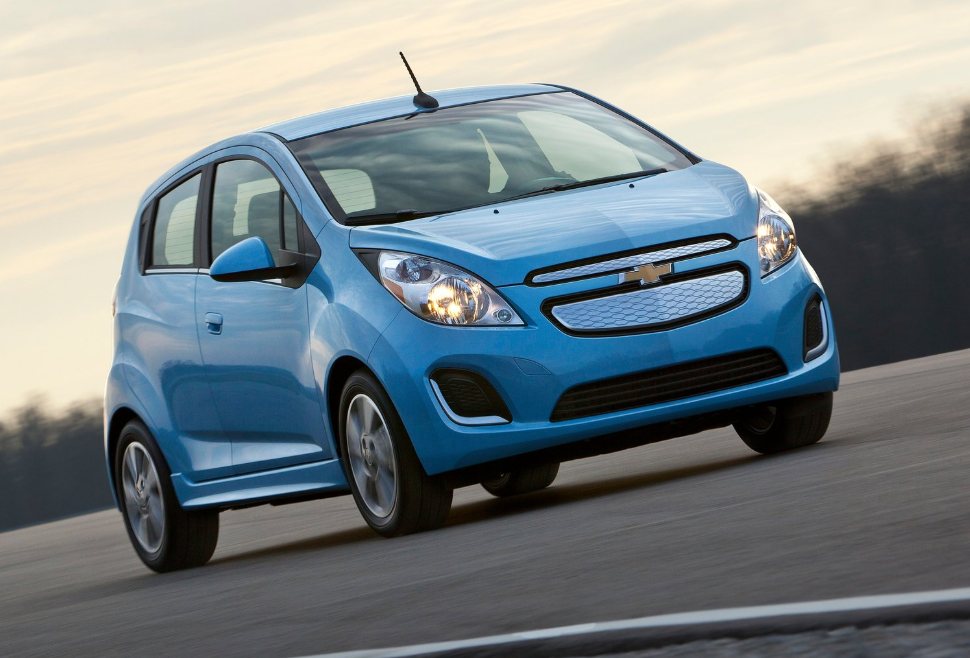
With the electric car market as big and important as it is now, President Mark Reuss, understandably, wishes GM weren’t so quick to lower the EV1 to its grave. When asked about what he’d change with hindsight in an interview with InsideEVs, he brings up the revolutionary EV almost immediately:
I wasn’t around for EV1; I wasn’t in the company. But I think that might have been one example of something that we, the company, should not have done, which was canceling that; that was really quite a car.
The EV1 was a game-changer for a lot of reasons. It introduced stuff like low-rolling-resistance tires, regenerative braking, HVAC heat pumps, and keyless ignition. Gen-two cars got nickel-metal hydride (NiMH) batteries, which doubled range, while third-generation cars got even longer-range lithium-polymer batteries. It also had a drag coefficient of just 0.19, beating out modern equivalents like the Lucid Air and the Mercedes-Benz EQS. While most other manufacturers hadn’t even figured out EVs, GM was already hundreds of steps ahead. Who knows just how far ahead the company would be now in the EV space had it stuck with developing the car further.

While Reuss believes the EV1 was a stopping point, others at the company believed it was a stepping stone. Gary Witzenburg, GM’s EV program Vehicle Test and Development manager during the EV1’s development, said as much in 2021 in a retelling of the car’s chaotic history, which he wrote for Hagerty:
The momentum the EV1 program generated led to fuel cell electric vehicle (FCEV) research; Allison hybrid buses; plus “two-mode” hybrid technology for trucks, SUVs, and two generations of extended-range electric (EREV) Chevrolet Volts. (Successful and satisfying as the Volts were, they were too costly to be profitable.) Now GM touts the battery-electric (BEV) Chevy Bolt and Bolt EUV, with many more electric vehicles to come.
Witzenburg believed it was limited battery tech that held GM back from building the EV1’s successor in the early 2000s, rather than cost or demand. Whether you agree with him or not, Reuss seems to have learned from the past, going by the rest of that InsideEVs interview:
I think the strategy that we set a few years ago to grow our company with electric vehicles and ICE vehicles, and being able to manufacture some of those in the same place, like Spring Hill, Tennessee, and have cell plants in the United States located in the places we do. You can talk about adoption rate, you can talk about where we are today. But all I know is the adoption rate isn’t as quick as what we thought it was going to be.
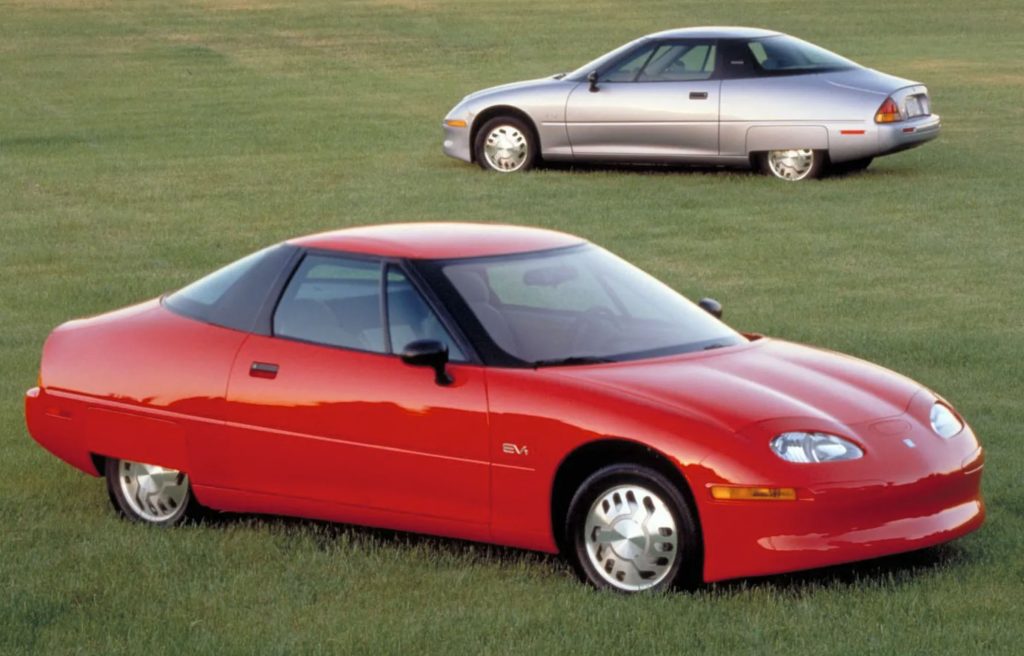
The tax credit goes away, what’s going to happen? We’re going to see what happens. But I can tell you that a high percentage of people with buying a electric vehicle, for instance, buy another one. Yeah. So that’s a really good flywheel to be on, and a good trend that’s long term. And while the rate may fluctuate year to year in terms of how many, it’s permanent and it’s real. And I don’t I don’t see ever not being a big part of the U.S. auto industry.
So, despite the notion that EV sales will soon dip in America due to tariff costs and a lack of federal tax credits, don’t expect GM to give up on the tech any time soon.
You can watch the full interview below:
Support our mission of championing car culture by becoming an Official Autopian Member.
The post ‘That Was Really Quite A Car.’ GM President Admits Canceling The EV1 Was A Bad Idea appeared first on The Autopian.
You can’t fully avoid anger in your life. Even if you aren’t the type to get angry, sometimes the world just steps up and puts you in a position where your coping mechanisms break down and unregulated emotion breaks to the surface, usually in the form of an unproductive outburst.
Anger has shapes and genres. It comes in types and variations. Some seethe just under the surface, only rarely breaking out in fury. A few know no other way of dealing with their emotions, their only feeling is rage. Some relish it even as it burns. Others just march through their life with a constant background radiation of annoyance and grumpiness.
One of the main skills you develop as you grow up is handling your own emotions. Maturity means emotional regulation – not absence or denial of emotion, but regulation.
This can be hard if you don’t have many examples or role models, such as when your parents are absent or suffer from their own inability to manage their emotions.
Not impossible, but can be hard.
Environmental factors have an effect. Hunger and malnutrition can compromise your ability to handle your emotions. The correlation between lead additives in fuel and global crime rates hints at the possibility that pollution might also be a factor.
Media is another.
There’s plenty to be angry about in life and being reminded of them can infuriate. Media – social, broadcast, news – can make us angry.
Media itself is never angry. Text has no emotion. It doesn’t feel. Video isn’t infused with a miasma of rage that infects those that watch it.
Those who make the media have emotions while making it. Those who experience media have emotions as a result of the experience. The medium itself is a tool shared by the two groups.
The side that creates sets in place structures, pacing, rhythms, symbols, and signals that play with conventions and precepts to convey a message to the other side. The “reader” decodes, interprets, deconstructs, and reassembles a meaning that’s built out of their experiences and expectations using their skills at understanding media.
It’s a tool on both ends and most of us on the receiving end have been doing our “decoding” for so long that we often forget that it’s a skill we’ve practiced and can improve. None of it is natural.
This is why generated media is often so vacuous, there is less intent behind it – mostly references and formulaic adherence to accepted conventions – leaving the burden of constructing meaning entirely on the consumer, and there’s a hard limit to how much meaning can be made out of what’s effectively an empty balloon: all surface filled with air.
It’s also why the entire “AI” bubble is, well, built on hot air. The intelligence people see in the chatbots is one they construct themselves. The model statistically assembles common patterns from a massive language data set and you are the only one that brings sense to the table. The other players only bring nonsense and bullshit.
This bubble didn’t happen by itself, but was made to happen by the tech industry and those who work in the industry.
Not everybody is complicit, obviously. Given the worst job environment for tech workers since the collapse of the dot-com bubble, it’s hard to fault anybody who, when ordered to use “copilots” at work or add a pointless chatbot to a website, just grin and bear it.
But the AI Bubble isn’t limited to the pointless and unproductive. It’s an outright political project.
Numerous executives in tech repeatedly talk about how they think “AI” is going to replace workers. By their own account, that seems to be the point of the technology.
So far, the impact seems limited to a few select fields. Copywriters have been hit hard. Translators and illustrators are losing gigs everywhere I look. Training, especially in software development, seems to have been hit hard. Voice actors are getting replaced with generated voices.
The goal, if we are to take tech executives at their word, is to make these trends the norm, not the exception.
That is a political project. Attacking labour, deskilling the work force, and driving down wages, is fundamentally a political project and an extremist one at that.
Centrally managing language, using pervasive chatbot adoption as a lever to change corporate writing at scale, is another explicit goal of these companies. When Musk and Altman argue about which of their respective chatbots is less “left-wing”, their intent is clearly that they want to make all writing done with their tools less left-wing.
Centralised ideological control over all corporate writing is, again, an extremist political project, historically associated with violent authoritarianism.
We could go through how these tools are being used to power a wholesale takeover of our education systems, create a tiered system of healthcare access, and automate decisions to ensure that nobody can be held accountable for atrocious decisions, but it all comes down to the same, repeated point:
The AI Bubble is a right-wing political project that goes hand-in-hand with the ongoing resurgence of fascism.
It’s also fuelling a financial bubble large enough to threaten the stability of the global economy.
This is why it’s meaningless to talk about how the technology still has its uses, and that the fact that it’s mostly used in harmful ways at the moment shouldn’t be used to dismiss the tech as a whole.
The time to talk about what to salvage from the tech is after the bubble has been deflated, the political project to undermine our institutions stopped, and the machinery of political extremism has been dismantled.
It isn’t a coincidence that we’re seeing an increase in the number of people who have spent their careers in tech coming out with statements that there is a silent majority in tech that doesn’t believe in “AI” or the associated political machinery of disenfranchisement and deskilling.
The problem with these statements is twofold.
1. Tech isn’t a uniform community #
It’s possible that a majority of tech workers doesn’t believe in the bubble, very few of them work directly on “AI” in the first place and many only touch on it in ways that are truly incidental to their work. But a majority of management and the executive class absolutely do believe. Every survey to date of the management class shows that they overwhelmingly believe that “AI” is the future.
To claim that there is a silent majority of the tech management class that doesn’t believe in the over-hyped promises of the bubble is simply untenable.
2. Most influencers either stood by or outright attacked critics #
Tech is a pop culture. Very few of the decisions made in the industry are made rationally or empirically. Studies and tests are used to justify the emotional decisions of the executive or management class. Infrastructure and stack decisions are made hedonistically – “cool” tech that makes the engineers and devs feel good about themselves almost always gets a priority over “boring” tech that has no risks.
The industry, especially the software side of tech, is driven by emotion and a sense of what is fashionable. There is genuinely more grounded engineering – materials, machinery, process, supply chains, etc. – taking place in the fashion industry than there ever has been in the software industry.
That’s why it’s a pop culture, not a fashion culture.
What is “in” is defined by influencers and cultural authorities whose language is constantly grounded in emotion – “My AI Skeptic Friends Are All Nuts” being a recent example – and what little argument the texts or videos contain doesn’t amount to more than a loose sequence of evocations or references that are specific to the community in question. Not even straw men. More reminder of the straw men that you saw that one time on Hacker News a few years ago. Placeholders of arguments past.
These are vocal investors, former and current executives, people who have built their careers on promoting the currently fashionable tech – all people who through their influence are the true driver of the nuts and bolts decisions in the software industry. The executives set the direction, but the implementations of most software companies are decided by whatever the current crop of dev influencers things is cool and trendy or, if your organisation is large enough, by however your internal “influencers” fixate on this quarter.
Overwhelmingly, this group of people, who hold enormous sway over how things get done in the industry, either went all-in on “AI” or, worse yet, consistently opposed those who have been trying to warn about the path that the “AI” project is taking
They actively opposed or dismissed critics while at the same time pointing out some of the implementation issues that have cropped up all in an effort to position themselves as the “reasonable” alternative.
Effectively their message was:
Pay no attention to the people warning about the political, economic, educational, and societal risks this technology presents. It’s a “normal” technology that’s fine as long as you take care about things like prompt injections.
The problem is that it isn’t a “normal technology”. It is outright a political project.
There will be a reckoning #
The average lifespan of a fascist government is around ten to twenty years. Sometimes, historically, you get lucky and they collapse in much less time.
Either way, there’s a reckoning. The long-lived fascist governments gradually tighten their grip on society and anything that threatens that grip, such as self-serving oligarchs or an unstable financial bubble, tends to get dealt with.
The shorter-lived movements leave their large-scale supporters defenseless and, in many cases, quite obviously culpable for many of the actions they supported.
Either way, a financial bubble that’s reportedly seventeen times bigger than the dot-com bubble will pop and, when that happens, nobody will want to be remembered as a supporter of “AI”. Tech industry leaders better hope that the US fascist project will have fizzled out by then because the fascists are much less likely to take kindly on them messing up the grift than a functioning democratic justice system.
No matter what happens in US politics, the days of the AI Bubble are numbered, and a number of people in tech – mostly those with enough savvy to consistently position themselves as the “moderates” of tech by pretending that technologies that predominantly have either libertarian or authoritarian politics baked right into the structure are somehow politically neutral – are realising that they need to distance themselves from the centre of the bubble.
That’s why we’re seeing a number of blog posts, videos, and social media posts saying that most people in tech were only pretending to support the bubble, that their enthusiastic blog posts, exuberant social media posts, and angry dismissals of critics were all insincere and born out of a fear for their careers.
They claim to be a part of a responsible majority that, very responsibly, helped implement the bubble to preserve their career and now, very responsibly, are saying that they didn’t mean it.
Even as they, at the same time, claim that the technology itself is neutral and “normal” and that once the bubble passes we can continue right where we left off and find “reasonable” uses for a tech purpose-designed to deskill, destroy the labour force, and drive creative industries into extinction.
It comes across as insincere, is all I’m saying.
This is only happening because that destruction is already making people angry, the bubble popping will only make more people angry, and pretending that nothing’s happening will only serve to pour fuel onto the fire.
So, they’d like us to just focus our anger on the TESCREAL cultists, please and thank you. They were just doing their job.
But they genuinely didn’t have to do their jobs this way.
Unlike the ground infantry of the industry – coders, designers, support staff – the influencers, who have a platform and a voice, and the management, who made the decisions, are absolutely to blame for all of the useless chatbots that were pushed into unrelated apps, the wholesale takeover over education, the deliberate positioning of diffusion models as an alternative to photography and illustrations, and a long long list of intentional destruction of people’s livelihoods, environment, education, and community.
They are to blame and, because we have no other tool at hand and no mature outlet for justice, people will inevitably be angry.
This obviously helps nobody because anger, motivating as it is, is a loss of reason that makes us vulnerable to manipulation and exploitation.
The inevitability of anger #
Almost all of our experiences of politics and how society is governed are mediated through either TV or social media. News is delivered simultaneously as a twenty-four hour broadcast cycle and a constant bombardment of hearsay and paraphrases on social media.
- A link with clickbait text.
- News stations filling the endless hours with lies and misrepresentations.
- Posts on X, Bluesky, or Threads that provoke and enrage.
- Videos that manipulate and take things out of context.
These media have a shape and a set of affordances that mould whatever message they convey. Once you boil down what you want to say to fit in a video or a social media site’s character count, you peel away all nuance and moderation.
What you’re left with is text that enrages, even if that wasn’t what you were feeling at the time.
This essay is almost 2500 words. The Bluesky equivalent I posted yesterday while I was working on a draft of this piece, with all of the argument and context stripped out, was little over a hundred words:
In the late stages of the bubble we’re starting to see multiple “people in tech don’t really believe in all of this, honest, we just act like it because we think we have to”, but the truth is that it doesn’t matter. What matters is that you’ve been acting like a true believer and you are what you do.
In work and politics, it genuinely doesn’t matter what you were thinking when you actively aided and abetted in shitting on people’s work, built systems that helped fascists, ruined the education system and pretty much all of media. What matters, and what you should be judged on is what you did.
An argument for moderation and consequence becomes a provocation – an incitement of the crowd – and the easiest emotion for the reader to construct from their end of the tool that is text, is “justifiable” anger. Mixed but reasoned emotions are boiled down to rage.
We live in a world where our most accessible forms of expression – the ones that we all marinate in day in, day out – have been confined, dismantled, sanded off, and stripped down until its mechanisms are too limited, too simple, to easily convey anything other than the simplest of emotions: anger or mockery.
There are people who manage to push the boundaries of the form and, within specific contexts, deliver more, whether it’s poetic, artistic, or simple clarity.
But they aren’t the norm and the work they do is harder than it should be.
We need to click past the “AI” summaries, rage-baiting social media posts, and read the text itself.
Anger is inevitable. You can and should minimise your exposure to triggers, but even with the greatest care it will sneaks up on you and, at least temporarily, some of your reason will leave you. The trick isn’t to prevent anger, to never become angry about anything in your life, but to recognise it when it arrives – the warning signs of when it takes hold of you – and defuse it before it does you harm. Walk away from the trigger. Talk about your feelings instead of what’s triggering your feelings. Focus on the facts, in context, instead of just the parts that enrage.
All of which requires space and nuance.
The only way we can counter the inevitability of anger is by fostering and participating in a wider selection of media than just social media and TV-like video platforms. We need movies. We need books. We need the support and structure of longer articles. When we are faced with the anger triggers that are baked into social media, we need other media to serve as a distraction from the triggers, a space for us to explore facts in a more nuanced and holistic way, and – which is a key part of our long, long history of art and media – give us an avenue to explore our emotions and feelings in healthy ways that don’t involve shouting at people.
Social media is confined.
We need space to spread our wings.
I think one of the things about getting cars to drive themselves that seems to be consistently overlooked by many of the major players in the space is just how much of the driving task has nothing to do with the technical side of things. Sure, the technical side is absolutely crucial, and the problem of how to get a car to interpret its surroundings via cameras, lidar, radar, whatever, and then use those inputs to construct a working model with reasonable actionable moments at over a mile a minute or more is absolutely impressive. But that’s only part of the equation when it comes to driving, especially driving among humans. There’s all sorts of cultural and environmental and other complex and often fuzzy rules about driving among human activity to consider, and then there are the complicated concepts of intent and all the laws and the strange unwritten rules – driving is far more complex than the base mechanics of it.
All of this is to say that Tesla’s re-released Full Self Driving (FSD) and its new mode known as Mad Max is something interesting to consider, mostly because it is software that is designed to willfully break the law. I’m not sure what other products are out there in the world that are like this; sure, you can buy a knife at Dollar Tree and commit any number of crimes with it, but the knife doesn’t come from the factory with the ability to commit crimes on its own, except perhaps for loitering.
Oh, and as an aside, Tesla’s icon for the Mad Max mode feels a little misguided. Let me show you:

That little guy with the mustache and cowboy hat doesn’t really look like what we think Mad Max (lower left) looks like; it looks much more like an icon of Sam Elliott (lower right). Unless they mean some other Mad Max? Maybe one that won’t get them in trouble with Warner Bros?
Anyway, back to the Mad Max speed profile itself. Among Tesla fans, the new mode seems to make them quite excited:
Tesla FSD V14.1.2 Mad Max mode is INSANE.
FSD accelerates and weaves through traffic at an incredible pace, all while still being super smooth. It drives your car like a sports car. If you are running late, this is the mode for you.
Well done Tesla AI team, EPIC. pic.twitter.com/Z1lFB1jCrR
— Nic Cruz Patane (@niccruzpatane) October 16, 2025
Tesla’s Mad Max Speed Profile for their latest release of FSD V14.1.2 is actually programmed with the ability to break laws, specifically speeding laws. Here’s how Tesla’s release notes describe the new profile (emphasis mine):
FSD (Supervised) will now determine the appropriate speed based on a mix of driver profile, speed limit, and surrounding traffic.
– Introduced new Speed Profile SLOTH, which comes with lower speeds & more conservative lane selection than CHILL.
– Introduced new speed profile MAD MAX, which comes with higher speeds and more frequent lane changes than HURRY.
– Driver profile now has a stronger impact on behavior. The more assertive the profile, the higher the max speed.
The description doesn’t specifically say it’ll break any laws, but in practice, it definitely does. Here’s a video from well-known Tesla influencer-whatever Sawyer Merritt where you can clearly see the Tesla hitting speeds up to 82 mph:
Those 82 miles per hour occurred in a 55 mph zone, as the Tesla itself knows and is happy to display on its screen:
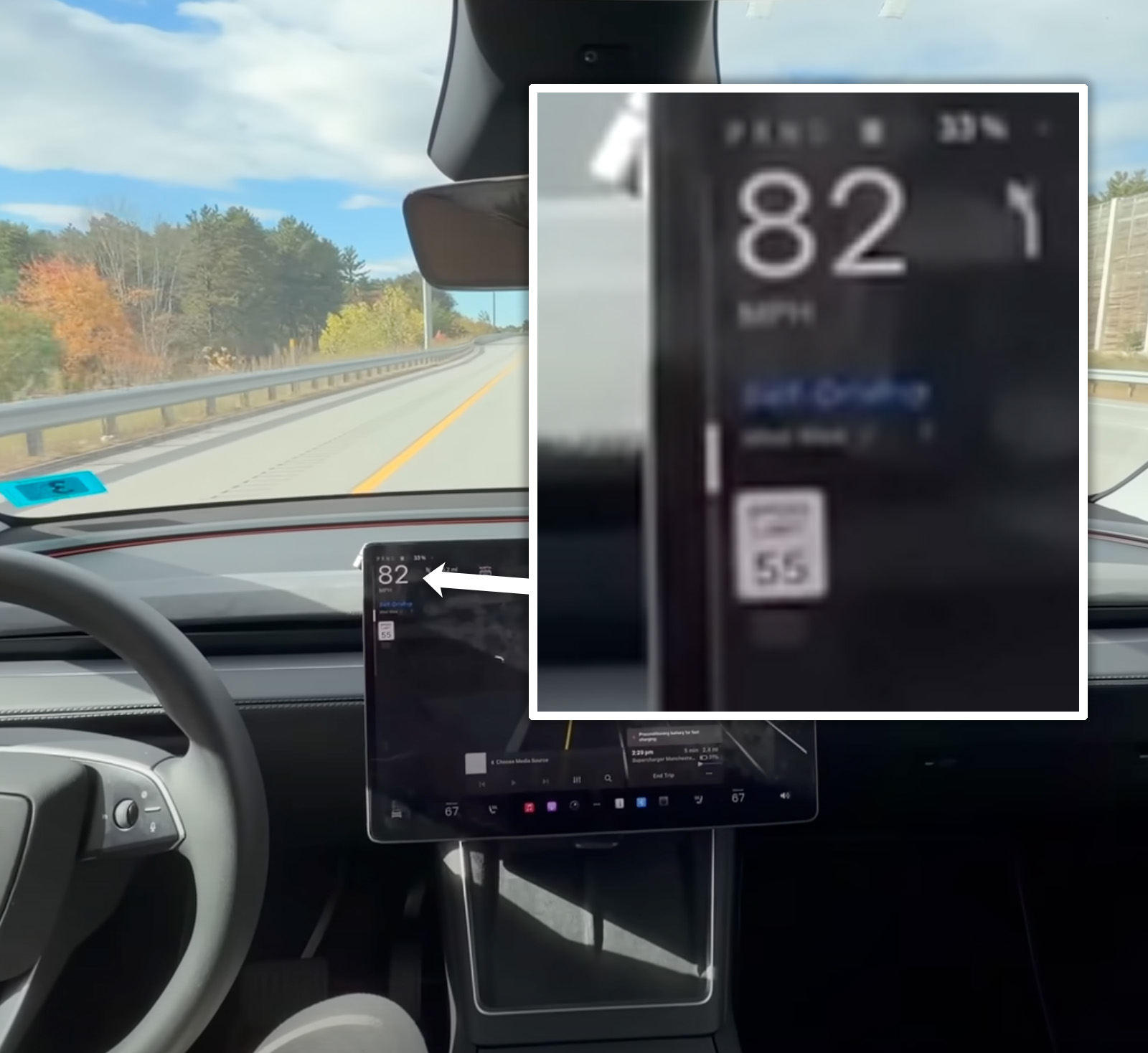
Why am I bringing this up? It’s not because I’m clutching any pearls about speeding (I don’t even have pearls, at least not real ones, I only have testicles to clutch as needed), because it’s no secret that we all do it, and there’s often a “folk law” speed limit on many roads where people just sort of come to an unspoken agreement about what an acceptable speed is. But that doesn’t mean it’s not breaking the law, because of course it is. And when you or I do such things, we have made the decision to do so, and we are flawed humans, prone to making all manner of bad decisions, or even just capable of being unaware, which, of course, ignorantia legis neminem excusat.
But this Tesla running FSD (supervised) is a different matter. FSD is, of course, a Level 2 system, which means it really isn’t fully autonomous, because it requires a person to be monitoring its actions nonstop. So, with that in mind, you could say the responsibility for speeding remains on the driver, who should be supervising the entire process and preventing the car from speeding, at least technically.
But maybe the driver is more of an accomplice, because the car knows what the speed limit is at any given moment; it’s even displayed onscreen, as you can see above. The software engineers at Tesla have this information and could have put in the equivalent of a command like (if they were writing the software in BASIC) IF CURRENTSPEED>SPEEDLIMIT THEN LET CURRENTSPEED=SPEEDLIMIT, but they made a deliberate decision not to do that. Essentially, they have programmed a machine that knows what the law is, and yet chooses to break it.
It’s not even really that minor infraction, what we see in the example here; Merritt’s Tesla is driving at 27 mph over the stated speed limit, and if we look at, say, the Marin County, California Traffic Infraction Penalty Schedule, we can see how big a deal this speed-crime is:

I’m sure that’s impossibly tiny if you’re reading on a phone, so I’ll just tell you what it says: for going more than 26 mph over a 55 mph speed limit, it’s a total fine of $486 and a point on your license. That’s a big speeding ticket!
So, does this make sense? Even if we all speed on highways at times, that’s very different than a company making and selling a product that is able to or at least willing to assist in violating a known law. Again, this is hardly high treason, but it is a crime, and it’s a crime perpetrated by a machine, with the full blessing and support of the parent company. There are tricky ethical issues embedded in this that we really should be thinking about before we start mass deploying 5,000-pound machines with a healthy disregard for the law into the public.
Does the fact that this software willingly breaks traffic laws affect Tesla’s potential liability if anything should go wrong? I’m no lawyer, but it’s hard to see how it wouldn’t come up if a car running FSD in the Mad Max speed profile were to get into a wreck. Why are decision makers at Tesla willing to put themselves at risk this way? It seems like such a huge can of worms that you would think Tesla would rather not open, right?
If someone gets pulled over for speeding while using this system, can they reasonably claim it wasn’t their fault but was the fault of the car? It’s significantly different than a car on cruise control, because those systems require the driver to actively set the maximum speed; in this case, FSD decides what speed to drive. But the person did choose a speed profile that could speed, so are they responsible? Or does it come back around to the fact that speeding is possible at all in that profile?
This is complicated! Cars have always had the ability to break laws if driven in ways that didn’t respect the law, but this is beyond just an ability. This is intent. The fact that the software knows it can break a law almost makes it premeditated.
I’m not saying this is a terrible thing that must be stopped, or anything like that. I am saying that this software is doing something we’ve never really encountered before as a society, and it’s worth some real discussion to decide how we want to incorporate this new thing into our driving culture.
It’s up to us; just because these cars can break speed limits doesn’t mean we have to just accept that. We humans are still in charge here, at least for now.
The post Tesla’s FSD ‘Mad Max Mode’ Will Ignore Speed Limits, Sense appeared first on The Autopian.
